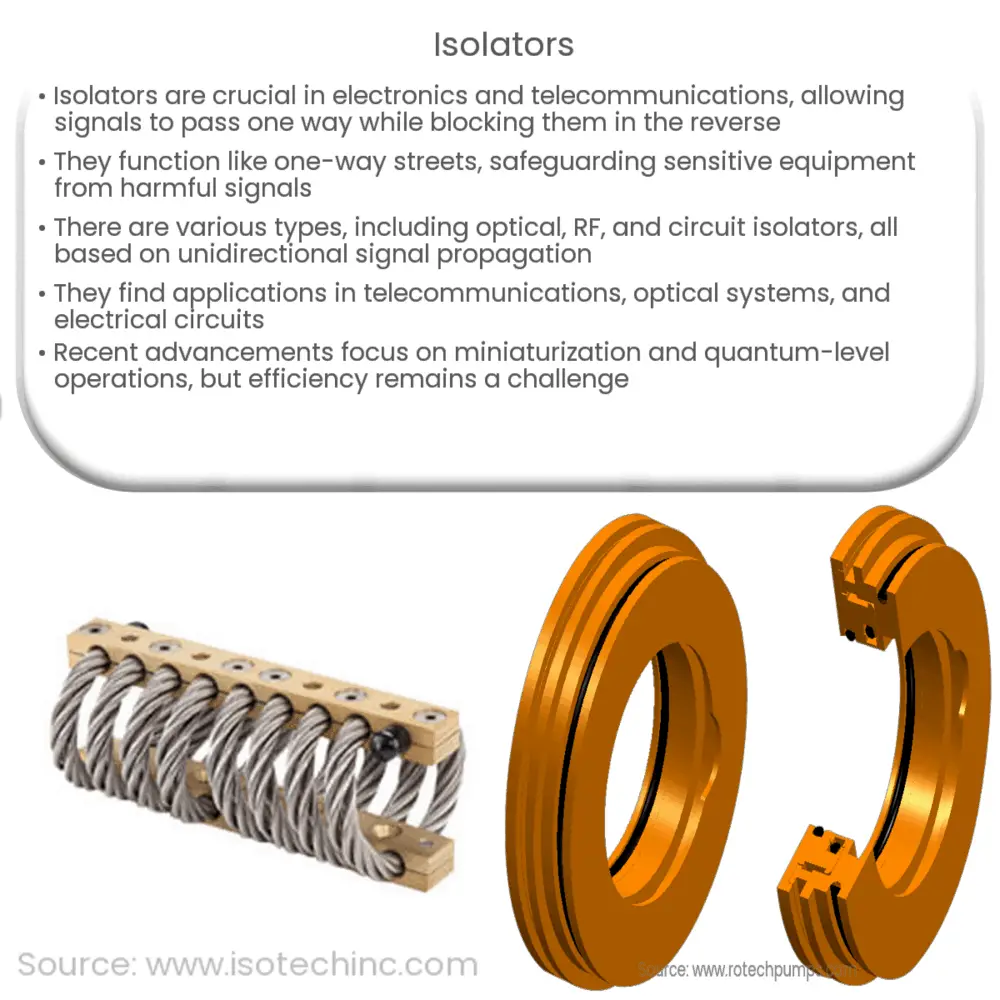Explore the world of isolators, their types, working principles, applications, modern developments, challenges, and their future potential.

Introduction to Isolators
Isolators are a vital part of many technological systems, specifically those in the field of electronics and telecommunications. At the most basic level, an isolator is a device that allows a signal to pass through in one direction while blocking it in the opposite direction.
Understanding the Importance of Isolators
Imagine a two-way street where you only want traffic to flow in one direction, and any vehicle attempting to travel in the opposite direction would be stopped. That’s fundamentally what an isolator does with electronic signals. Isolators effectively protect sensitive equipment from potentially damaging signals coming from the opposite direction.
Types of Isolators
- Optical Isolators: These types of isolators are used extensively in optical communications. They allow light (an optical signal) to pass in one direction while blocking it in the opposite direction.
- RF Isolators: RF (Radio Frequency) isolators are used in radio frequency communication systems. They are designed to ensure that RF signals pass through in one direction and are blocked in the other.
- Circuit Isolators: Circuit isolators are used in electronic circuits to prevent unwanted signal feedback that could disrupt or damage the circuit’s operation.
The Working Principle of Isolators
Although the specific working principles of isolators can vary depending on the type, all isolators fundamentally rely on the concept of unidirectional signal propagation. This can be achieved through a variety of mechanisms.
For instance, in an optical isolator, also known as an optical diode, the device typically consists of an input polarizer, a Faraday rotator, and an output polarizer (also known as an analyzer). The Faraday rotator changes the polarization state of light as it passes through, such that it can pass through the analyzer in one direction but is blocked when attempting to pass in the opposite direction.
In an RF isolator, a similar principle applies, but the implementation is different due to the nature of RF signals. A common type of RF isolator is the ferrite isolator, which uses magnetic properties of certain materials to allow signal propagation in one direction but block it in the reverse direction. For instance, if an incoming signal encounters a change in magnetic orientation (also known as “magnetic bias”), it can no longer pass through, thereby achieving isolation.
Applications of Isolators
Isolators are used across a variety of fields, some of which include:
- Telecommunications: In the telecom industry, isolators protect devices from the damage caused by signal reflection, especially in RF communication systems where reflected power can damage the transmitter.
- Optical Systems: Optical isolators are extensively used in lasers to prevent the back-reflection of light, which could destabilize the laser operations.
- Electrical Circuits: Circuit isolators are used to protect devices from voltage spikes and surges in electrical power systems. They can also help reduce electrical noise, which can interfere with the accurate transmission of signals.
Modern Developments in Isolators
In recent years, there have been significant advancements in isolator technology. For example, the miniaturization of isolators has allowed for their use in increasingly small and compact devices. Researchers are also exploring the possibility of isolators that operate at the quantum level, opening up the potential for more secure quantum communication systems.
The Limitations and Challenges
Despite their vast applications and advancements, isolators do have limitations. The design and manufacture of isolators require precision and understanding of the underlying principles of electromagnetism and optics. Moreover, the efficiency of an isolator is also a challenge. While ideal isolators would have 100% efficiency, in reality, some power is always lost in the process. The challenge lies in maximizing efficiency while minimizing power loss.
Conclusion
In conclusion, isolators play a critical role in various fields such as telecommunications, optical systems, and electrical circuits. They help protect sensitive equipment from potentially damaging signals and ensure the smooth and efficient operation of these systems. Despite some limitations and challenges, ongoing technological advancements continue to enhance the potential applications and efficacy of isolators. The future holds promising developments for isolator technology, particularly in the realms of miniaturization and quantum communication.



